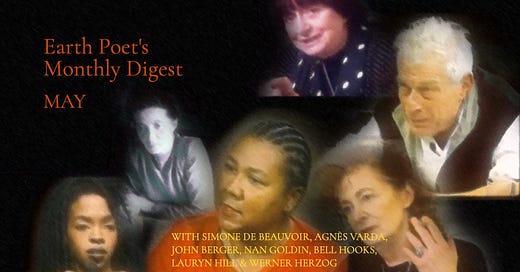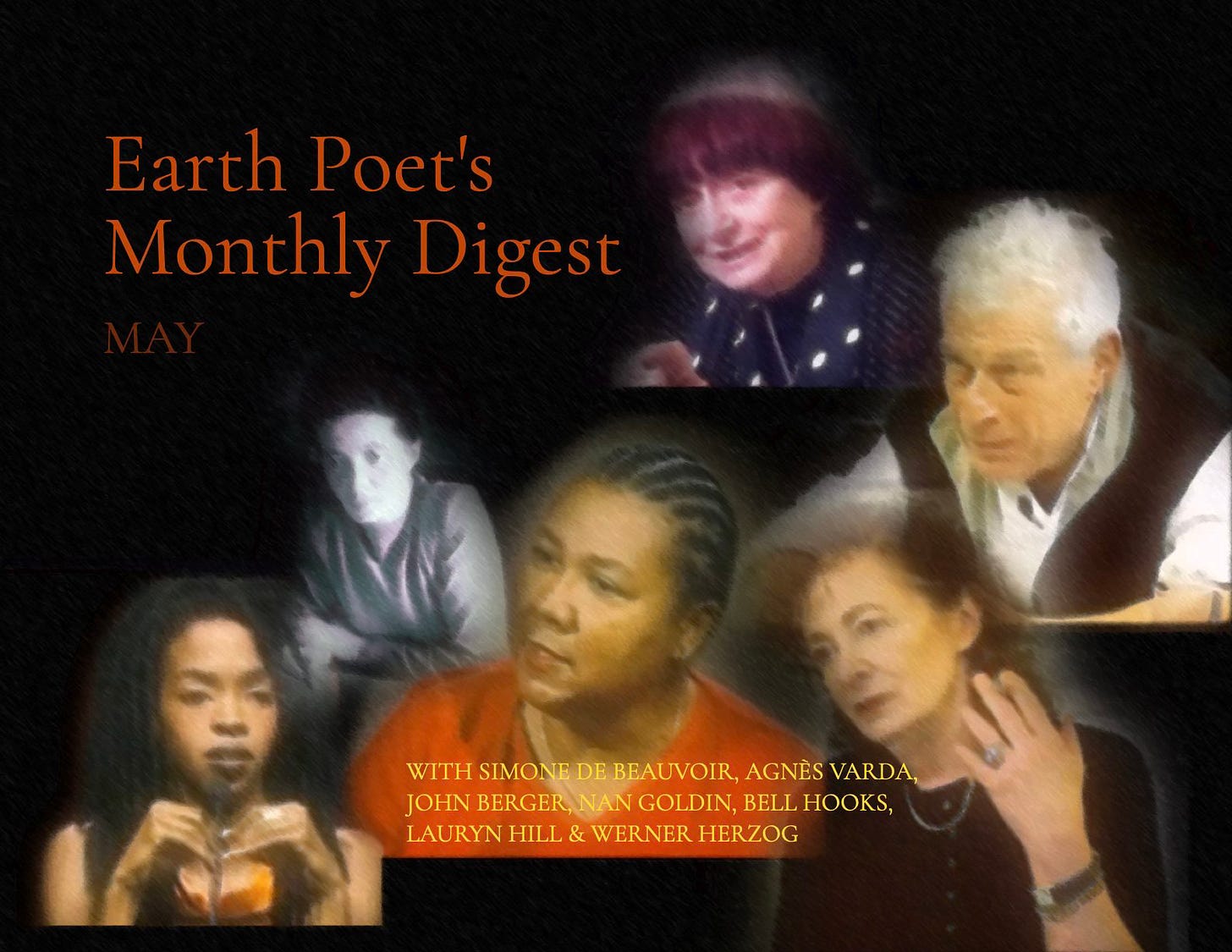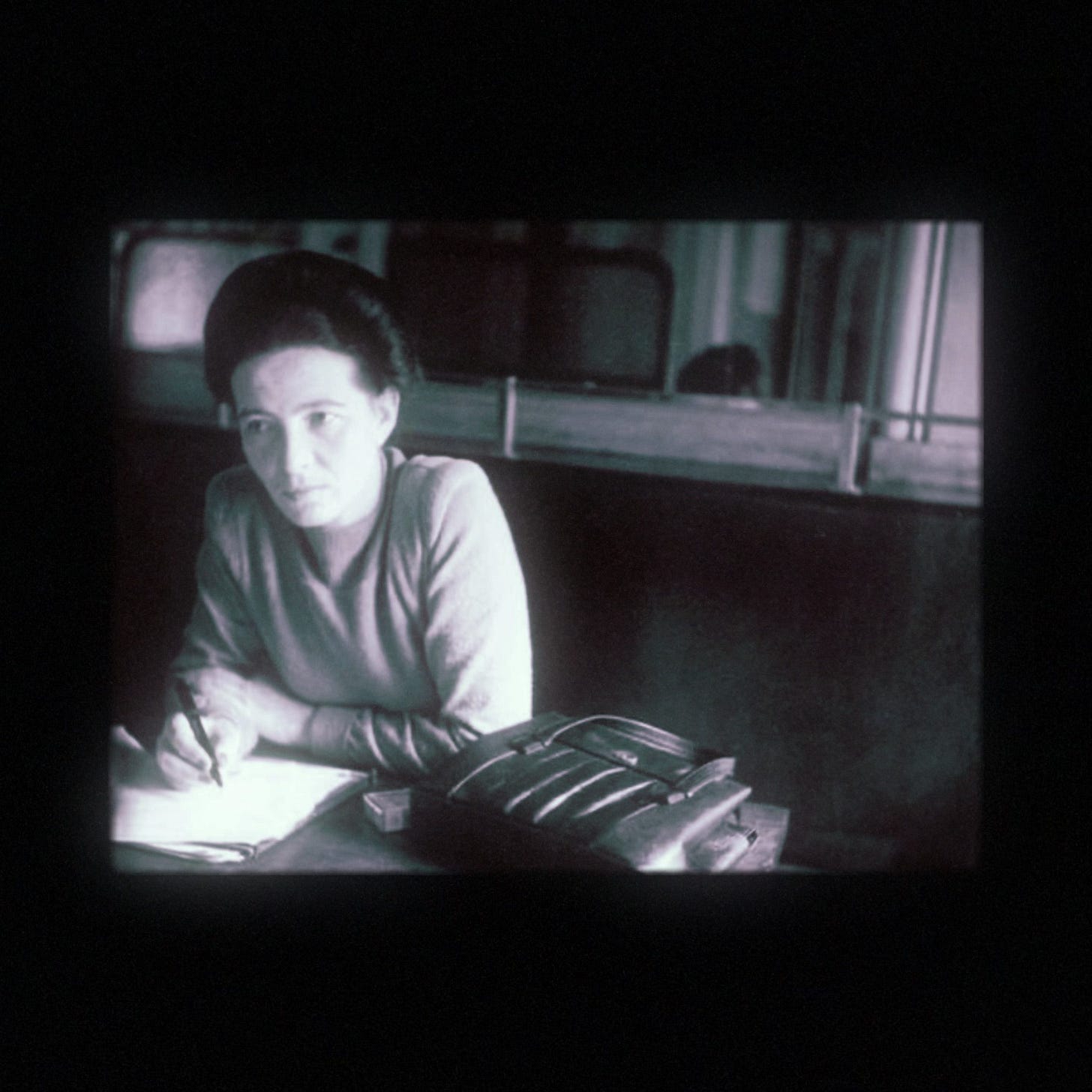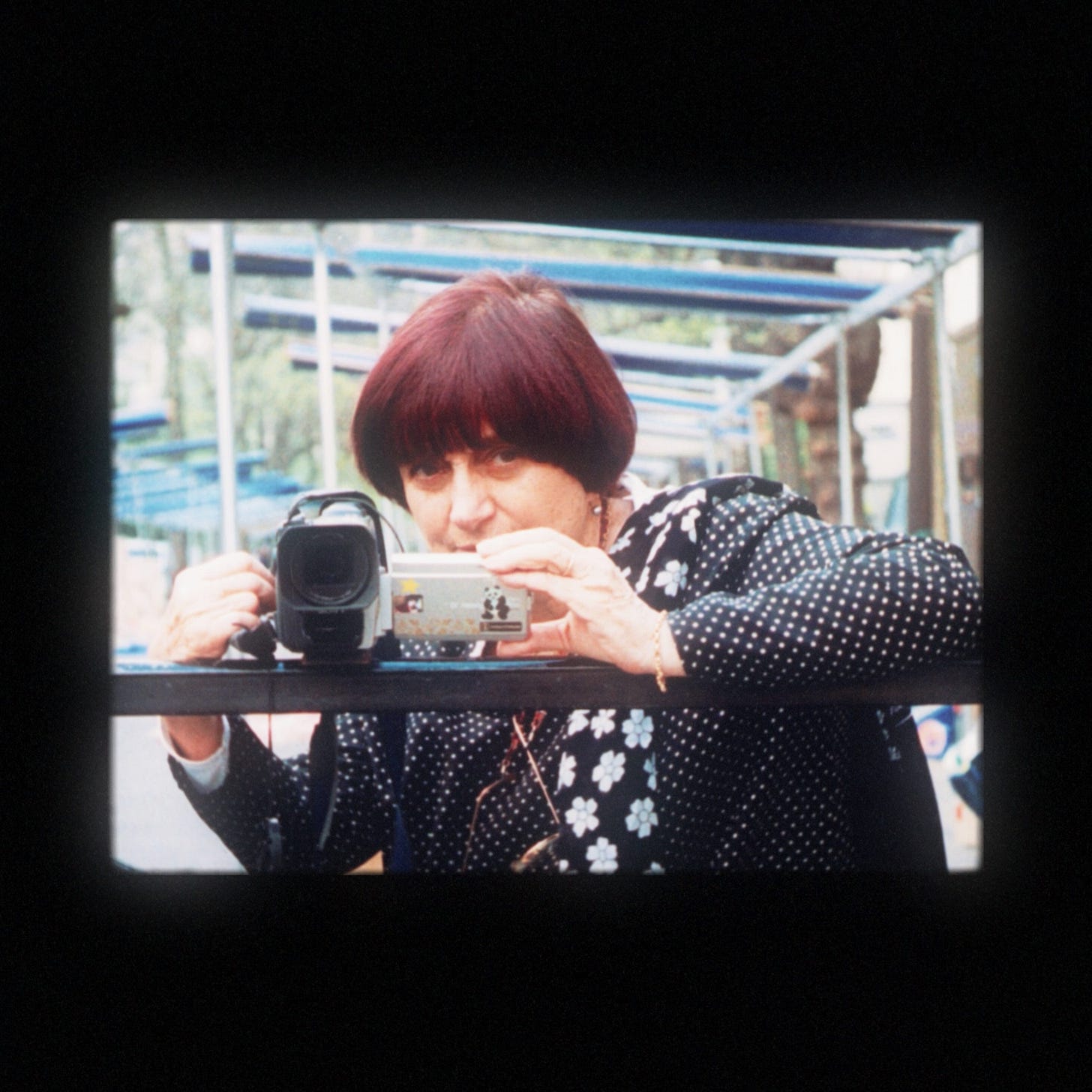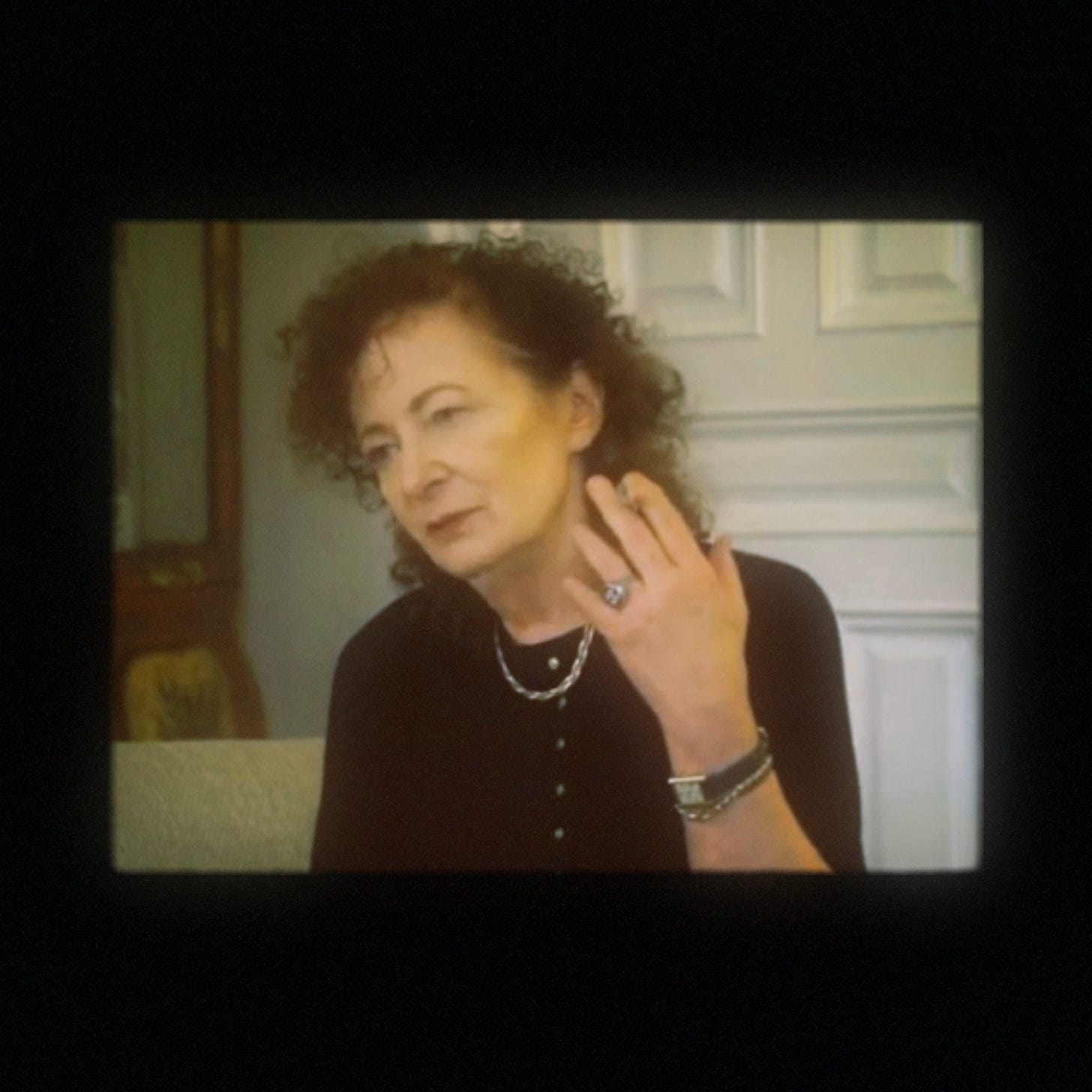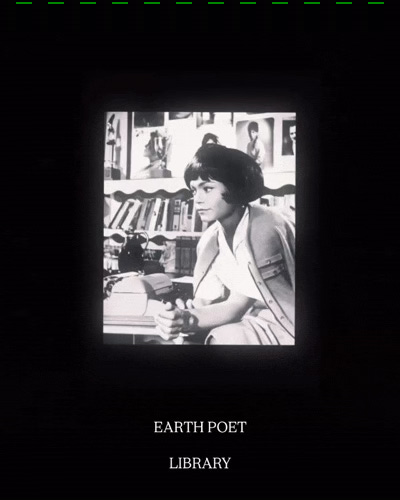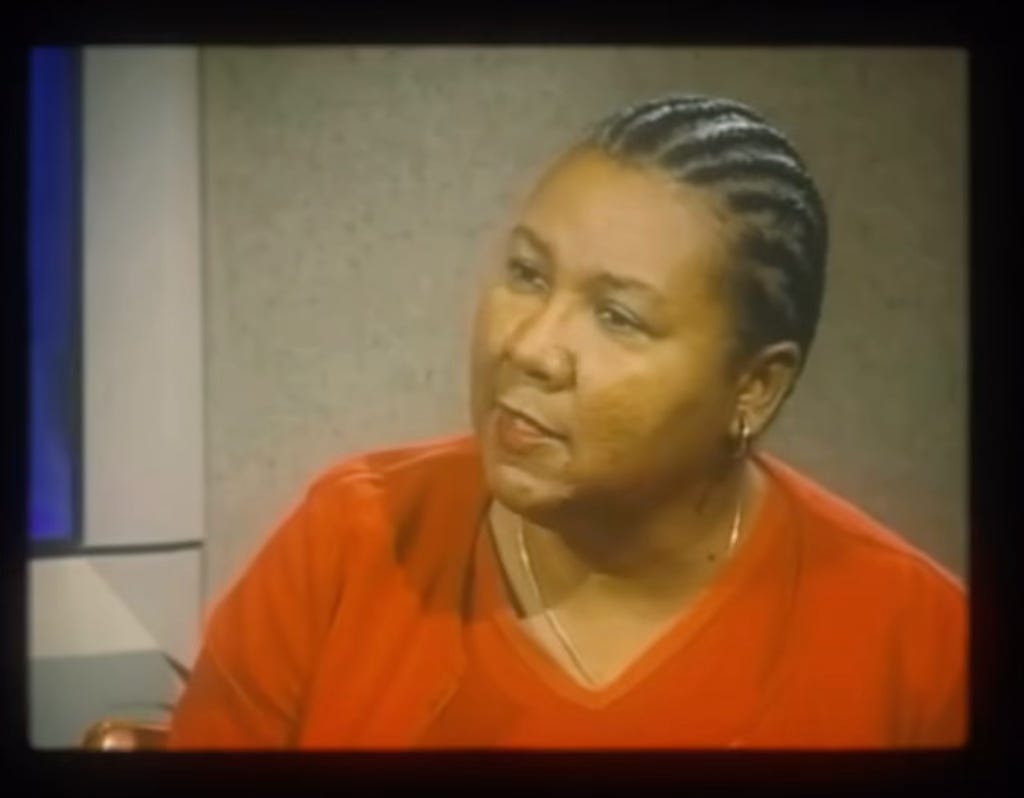Earth Poet's Monthly Digest
May with Simone de Beauvoir, Agnès Varda, John Berger, Nan Goldin, bell hooks, Lauryn Hill & Werner Herzog
In our monthly digest, we gather the letters and fragments shared across the Earth Poet Substack and Instagram.
This month includes essays on Simone de Beauvoir taking down of the term “girlie”, Agnès Varda Leading a Creative Life on Her Own Terms and Nan Goldin’s Plea for Getting Off our Phones; we also start off Earth Poet Library with its first volume, in conjunction with the Nan Goldin essay, about Yearning for an Analog Life and look at 5 Photographers who’s work, talks and books can help us with exactly that. Lastly, in our essay last week, we look at bell hooks’ timeless wisdom on How to Find Love.
In our recent clips, we explore a range of voices reflecting on love, storytelling, and the mystery of being human. We begin with Simone de Beauvoir, who powerfully challenges the idea of an innate feminine energy. John Berger, in his signature storytelling mode and narrative brilliance, guides us through his reflections on Tenderness as a Response to Pain and as a Defiant Act of Freedom. In another clip, he shares why storytelling is so essential to him and why he is so proud in calling himself a storyteller.
Agnès Varda speaks about her love for documentary filmmaking, using it as a lens to uncover beauty and mystery in people’s lives. Of course, we couldn’t go a month without Werner Herzog — who makes a quick but sharp appearance to tell us what every filmmaker must do to succeed.
bell hooks offers a piercing insight into how Care is often mistaken for Love, drawing from her own experience. And finally, Lauryn Hill brings a different perspective, reflecting on the Complexities of Love and the Pain it sometimes carries.
Letter 4: Simone de Beauvoir Against the "Girlie"
On "Feminine Energy" as a Social Construct, the Infantilisation of Womanhood and How Her Philosophy Can Help Us Live More Freely
“One is not born, but rather becomes, a woman.”
— Simone de Beauvoir, The Second Sex (1949)
Femininity as a Social Construct & Lifelong Performance
In the last few years, hashtags like #GirlDinner, #GirlMath, and #HotGirlWalkhave amassed billions of views on TikTok.
A new generation of young women is embracing hyper-feminine identities — celebrating softness, humor, and curated self-expression — often in a tongue-in-cheek manner.
Yet this is femininity not just as behavior, or even as identity — it is femininity as an aesthetic performance: a curated, emotionally resonant version of self, styled, shared, and made viral.
It’s identity transformed into content.
And while much of it is framed as irony or empowerment, it also, even in jest, reintroduces an old pattern: the infantilization of women by women themselves.
Simone de Beauvoir saw femininity not as a biological essence but as a social construct — something imposed rather than inherited.
What society defines as “feminine” is not innate, but shaped by culture, expectation, and upbringing.
Simone de Beauvoir Against innate “Feminine Energy”
“I wanted to change the condition of women, not to amuse myself writing.”
— Simone de Beauvoir
“Little girls are not born loving pink or playing with dolls. They are taught to be that way.”
— Elena Belotti, What Are Little Girls Made Of (1973)
This clip is from the fascinating 1975 interview of Simone de Beauvoir with Jean-Louis Servan-Schreiber, Why I'm a Feminist, with Simone de Beauvoir discussing why she thinks there is no such thing as “feminine energy”.
View more clips on the Earth Poet Instagram channel…
Letter 5: Agnès Varda on Leading a Creative Life on Your Own Terms
How to Cultivate a Creative Life Against Social Constraints with 5 Practices Used by Agnès Varda herself
Leading a Creative Life as an Antidote to Societal Constraints
“I'm interested in people who are not exactly the middle way or who are trying something else because they cannot prevent themselves from being different, or they wish to be different, or they are different because society pushed them away.”
— Agnès Varda
Time has always lived in a woman’s body. As a woman, you grow up — without being told directly — that your body is a clock, ticking. The warnings arrive early: Don’t waste your best years. Don’t wait too long. Use your twenties to explore. Settle down by thirty. Better make your forties count, and so on. Fertility, unfairly, gives a deadline and it makes youth become another currency. Leading a creative life can be a beautiful antidote to these social constructs.
Creativity in the Time of Social Media
Social media has rewired our sense of time. It feeds us a constant stream of people — some we know, most we don’t — launching books, selling out shows, landing agents, building empires. It’s not just personal. It’s cultural. A quiet, ambient pressure to move faster, do more, be visible.
Agnès Varda on Finding Mystery and Beauty in People through Documentary Filmmaking
“I try to capture reality, but also what is strange in people, because everyone is full of beauty.”
— Agnès Varda
“What interests me is life, and I try to film it with respect and tenderness.”
— Agnès Varda
View more clips on the Earth Poet Instagram channel…
John Berger on Tenderness as a Response to Pain and redefining it as a Defiant Act of Freedom
“Tenderness is the passion of the body to share with another body.”
— John Berger
John Berger, in his signature storytelling mode and narrative brilliance, guides us through his reflections on Tenderness as a Response to Pain and redefining it as a Defiant Act of Freedom. In his conversation with Michael Silverblatt, John Berger says:
It seems to me that one of the essential elements of tenderness is that it is a free act. A gratuitous act. It has an enormous amount to do with liberty. With freedom. Because one chooses to be tender. And in a certain sense, in the face of, so often, what is surrounding us, it is an almost defiant act of freedom.
— John Berger
John Berger on Being Proud of Being a Storyteller
“All storytellers are deeply honest because they cannot invent;
they can only tell what has already happened to them or to others.”
— John Berger
Interviewer: In your heart you are a storyteller, aren’t you?
John Berger: Yes, I completely agree with you. I mean, I feel that I am a storyteller, that’s all. That’s all, a storyteller.
Interviewer: But the trouble with storytellers is, they can be seen as very dangerous.
John Berger: Well, dangerous to what and to whom? If I am dangerous to those who run the new economic order, I am proud of that.
View more clips on the Earth Poet Instagram channel…
Letter 6: Nan Goldin Wants Us to Get Off Our Phones
Yearnings for an Analog Life: What 5 Photographers Can Teach Us About Bringing Slowness and Presence Into Our Digitally Sharpened Lives
Yearnings for an Analog Life
Over the last decades, our lives have become encapsulated by the digital world. Sometimes it feels like the digital is just as real — if not more real — than the physical. Everything is digitised. We use more and more screens in our daily life.
In response to give advice to young people, Nan Goldin said the following:
My advice to young people is to put down their phones.
That’s my advice. Don’t think it’s okay to live in your phone.
You have a lot more to say than Instagram.
And a lot to experience in the real world.
And the most important thing is, standing in front of another person and feeling empathy for them. And that can’t be done on the phone.
— Nan Goldin
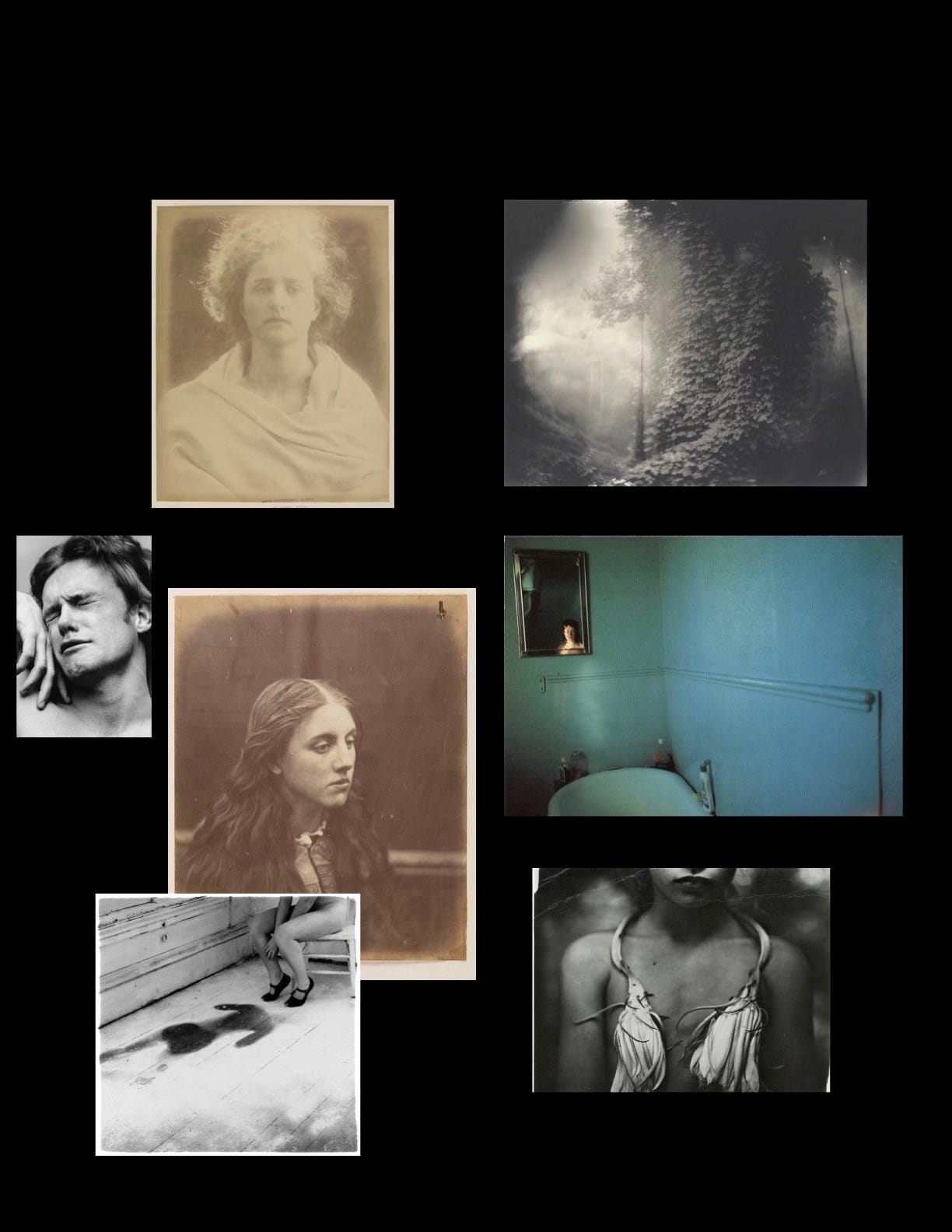
By growing up inside digital media, many of us have unlearned how to live without it. We want to. We try. But it’s hard — especially when so many of the apps we rely on are designed to keep us scrolling. The digital has a real hold over us. It brings convenience, connection, efficiency — but it also speeds everything up. It sharpens it. Our screens now have more pixels than the eye can see. And with that, the platforms we use every day have become more perfectionist, more sleek, more frictionless — engineered to smooth away the process, the mess, the hesitation.
So in this letter, as an antidote to the fast, sleek and digital, I want to turn to five artists and take refuge in their world of analogue photography: Sally Mann, Peter Hujar, Francesca Woodman, Julia Margaret Cameron, and Nan Goldin. From each of them, we will take one small thread from their practice as a way to stitch just one analogue moment back into your day.
Continue reading for:
Sally Mann on Practicing Real Focus
Peter Hujar on Resisting the Rush & Slowing Down
Francesca Woodman on Inhabiting the Body Without Performance
Julia Margaret Cameron on Embracing Blur and Emotional Texture
Nan Goldin on Telling the Truth, Even When It’s Messy
EARTH POET LIBRARY #1: Yearnings for an Analog Life
In conjunction with the essay Letter 6: Nan Goldin Wants Us to Get Off Our Phones, we are launching the Earth Poet Library — our book and film club. Each edition shares books, art, essays, talks and films that deepen the people and themes explored in our essays.
EARTH POET LIBRARY #1: Yearnings for an Analog Life
Instead of doomscrolling, dive into these books, documentaries, talks and artist monographs — featuring Sally Mann, Peter Hujar, Francesca Woodman, Nan Goldin and Agnès Varda

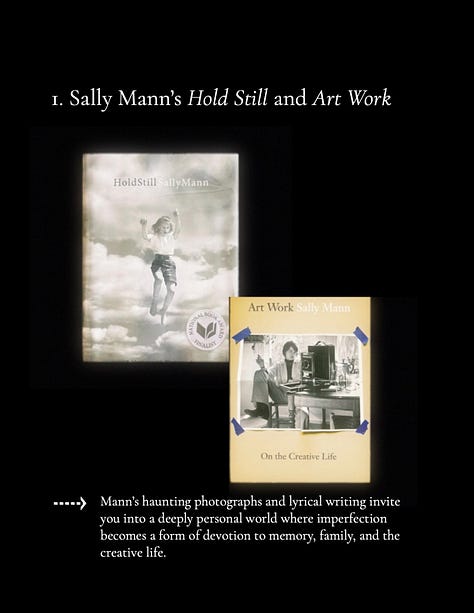
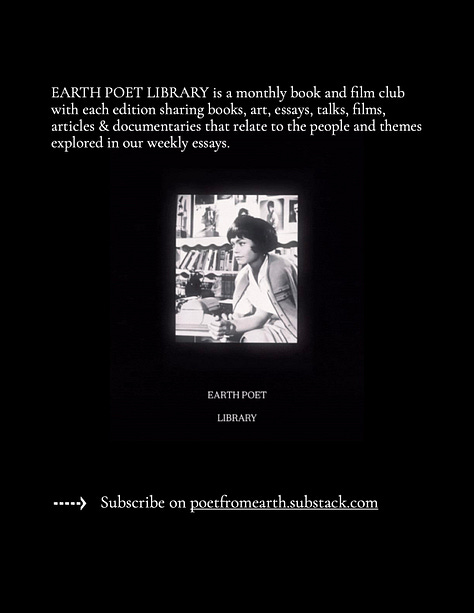
Letter 7: bell hooks on How to Find Love
bell hooks’ 5 Tips on How to Find Love At Every Age
When bell hooks book All About Love: New Visions came out in 1999 it was ahead of its time in challenging the way our culture misunderstands love, offering a new definition rooted in care, commitment, trust and spiritual growth.
bell hooks on Why Care Isn’t Always Love and Lauryn Hill on Love’s Painful Complexity
“Knowing how to be solitary is central to the art of loving. When we can be alone, we can be with others without using them as a means of escape.”
— bell hooks
“I can give away everything I possess, but am without love, and I have no happiness”
— Lauryn Hill
View more clips on the Earth Poet Instagram channel…
Thank you for reading & see you on Saturday for our weekly letter.
Much Love
— Earth Poet
Earth Poet is a weekly newsletter that unpacks quotes from cultural icons — writers, artists, provocateurs — and reflects on what they mean now, with creative rituals to explore and journal prompts for deep reflection — all woven into essays on cultural and social themes.
Free readers receive biweekly essays and digests. Paid subscribers unlock weekly essays, the Earth Poet Library Book & Film Club, the Monthly Dead Poet Advice column — where voices from the past answer questions from the present — and so much more.
References / Bibliography
Still from the documentary Simone de Beauvoir: Une femme actuelle. © Directed by Dominique Gros. Produced by Les Films d’Ici and INA (Institut National de l’Audiovisuel), France, 2007. Available here.
Clip from the 1975 interview Why I’m a Feminist. In this conversation with Jean-Louis Servan-Schreiber, © INA (Institut National de l’Audiovisuel), France, 1975. Available here.
Image by Rosalie Varda. Agnès Varda filming Les Glaneurs et la Glaneuse with a digital camera, 1999. © Ciné-Tamaris.
Conversation between John Berger and Michael Silverblatt. Recorded 2002. © Available here.
Image Still from Goldin, Nan, and Thora Siemsen. Nan Goldin and Thora Siemsen in Conversation. © Marian Goodman Gallery, 21 Oct. 2022. YouTube, here. Accessed 21 May 2025.
Image Still bell hooks from © Word on Words with John Seigenthaler, 1999 interview with bell hooks. Link.
Images Fig. 1 - 12
Image cover. Marian Goodman Gallery. (2024, April 9). Nan Goldin and Thora Siemsen in conversation [Video]. YouTube.
Figure 1. Sally Mann, Landscape Photography. Accessed via Landezine: https://landezine.com/landscape-photography-by-sally-mann/.
Figure 2. Sally Mann, Still Time: Photographs 1971–1991, Exhibition Card, Bucknell University, 1995. Accessed via Gallery 98: https://gallery98.org/2019/bucknell-university-sally-mann-still-time-photographs-1971-1991-card-1995/.
Figure 3. Peter Hujar, Orgasmic Man, 1969. Pigmented ink print. Pace Gallery. Accessed May 11, 2025. https://www.pacegallery.com/artists/peter-hujar/.
Figure 4. Peter Hujar, Palermo Catacombs #1, 1963. Gelatin silver print. Photograph © The Peter Hujar Archive / Artists Rights Society (ARS), New York. Accessed via The Guardian: https://www.theguardian.com/artanddesign/2024/apr/15/peter-hujar-new-york-demimonde.
Figure 5. Woodman, Francesca. Untitled, 1976. Gelatin silver print. Courtesy of George and Betty Woodman. Accessed via The New York Times: https://www.nytimes.com/2012/03/16/arts/design/francesca-woodman-at-guggenheim-museum.html.
Figure 6. Francesca Woodman, Untitled. Gelatin silver print. Accessed via PLEASE! Magazine: https://www.pleasemagazine.com/francesca-woodman.
Figure 7. Francesca Woodman, Untitled, Rome, Italy, 1977–1978. Gelatin silver print. Accessed via Artsy: https://www.artsy.net/article/artsy-editorial-reevaluating-francesca-woodman-early-death-haunts-groundbreaking-images.
Figure 8. Cameron, Julia Margaret. Aurora, Goddess of the Morning, 1865. Albumen silver print from wet collodion negative. Victoria and Albert Museum, London. Accessed May 11, 2025. https://collections.vam.ac.uk/item/O1424605/aurora-goddess-of-the-morning-photograph-cameron-julia-margaret/.
Figure 9. Julia Margaret Cameron, Aurora, Goddess of the Morning, 1865. Albumen silver print from wet collodion negative. Accessed via AnOther Magazine: https://www.anothermag.com/art-photography/gallery/7592/julia-margaret-cameron/4.
Figure 10. Julia Margaret Cameron, Suspense, 1864. Albumen silver print. Model: Kate Dore. Accessed via AnOther Magazine: https://www.anothermag.com/art-photography/7823/why-julia-margaret-cameron-is-photographys-secret-heroine.
Figure 11. Cameron, Julia Margaret. The Kiss of Peace, 1869. Albumen silver print from wet-collodion-on-glass negative. Accessed via Wikipedia: https://en.wikipedia.org/wiki/Julia_Margaret_Cameron#/media/File:The_Kiss_of_Peace,_by_Julia_Margaret_Cameron,_M197101590002.jpg.
Figure 12. Nan Goldin, I'll Be Your Mirror, folded card for the 1996 Whitney Museum of American Art exhibition. Front image: Self-portrait in blue bathroom, London, 1980. Inside image: Self-portrait by the lake, Skowhegan, Maine, 1996. Accessed via Gallery 98: https://gallery98.org/2018/whitney-museum-nan-goldin-ill-be-your-mirror-folded-card-1996/.


